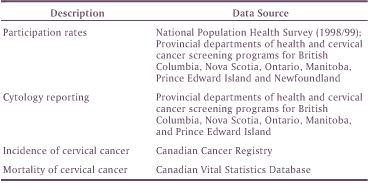ARCHIVED - Cervical Cancer Screening in Canada: 1998 Surveillance Report
Appendix C
Data Sources
Data for this report have been derived from multiple sources and are listed as follows:

National Population Health Survey (NPHS)
This biennial survey, designed and conducted at Statistics Canada since 1994/95, collects information about the health of the Canadian population. It covers household and institutional residents in all provinces and territories, except people living on Indian reserves, on Canadian Forces bases, and in some remote areas, and includes a longitudinal and cross-sectional component. Detailed information on sampling and survey methodology has been published elsewhereFootnote52 Footnote53.
The 1998/99 (cycle 3) cross-sectional sample is made up mostly of longitudinal respondents and their cohabitants; most of the interviews were conducted by telephone. Infants born in 1995 or later and immigrants who entered Canada after 1994 were randomly selected and added to keep the sample representative. To replace the sample that was lost to attrition, individuals in dwellings that were part of the original sampling frame but whose household members did not respond in 1994/95 were contacted and asked to participate. In 1998/99, the overall response rate was 88.2% at the household level. The response rate for the randomly selected respondents (aged 0 or older) in these households was 98.5%.
NPHS data are stored in two files. The General file contains socio-demographic and some health information obtained for each member of participating households. The Health file contains in-depth health information, which was collected for one randomly selected household member, as well as the information in the General file pertaining to that individual.
Longitudinal sample: Of the 17,626 randomly selected respondents in 1994/95, 14,786 were eligible members of the NPHS longitudinal panel, along with 468 persons for whom only general information was collected. An additional 2,022 of the 2,383 randomly selected respondents under age 12 were also eligible for the longitudinal panel. Thus, 17,276 respondents were eligible for re-interview in 1996/97, and 16,677 were still alive in 1998/99. A response rate of 88.9%, based on the entire panel, was achieved in 1998/99. Of the 16,168 participants in 1996/97, full information (that is, general and in-depth health information for the first two survey cycles or an outcome of death or institutionalization) was available for 15,670. The corresponding number for 1998/99 was 14,619 respondents. More detailed descriptions of the NPHS design, sample, and interview procedures can be found in published reportsFootnote52 Footnote53.
The NPHS has included questions on the utilization of Pap smears by women aged 18 and older. For the purposes of this report analyses were restricted to women aged 18-69 (n=6,498). Responses to two survey questions "Have you ever had a Pap smear test?" and if "Yes", "When was the last time you had a Pap smear test?" were used to obtain estimates of 3-year screening rates.
Canadian Cancer Registry (CCR)
The patient-oriented CCR (1992-) and its event-oriented predecessor, the National Cancer Incidence Reporting System (NCIRS) (1969-1991) contain cancer incidence data reported annually by provincial and territorial cancer registries to the Health Statistics Division at Statistics CanadaFootnote54 Footnote55. Completeness of registration for invasive cancers is considered to be about 95% or more from 1983 onwards. Statistics Canada annually provides an extract of this data file to Health Canada, where it is loaded into the ORIUS system to facilitate analysis. The NCIRS and CCR contain demographic, diagnostic and residence data for each invasive tumour diagnosed in residents of each province and territory. Cancer diagnoses are coded using the International Classification of Diseases in Oncology (ICDO), which includes codes for both the tumour topography (T) and morphology (M). For this project, invasive cancers were defined as ICDO-T codes 53.0-53.9. Morphology codes were grouped as follows:

Vital Statistics Mortality Data: Statistics Canada maintains mortality data for Canada as compiled from the vital statistics offices in each province and territory. Underlying cause of death is coded using the International Classification of Diseases, 9th revision. Data for cervical cancer deaths for this study were selected using ICD9 code 180.0-180.9 from a version of this data set supplied annually to Health Canada and stored on the ORIUS system. Cervical cancer deaths may be slightly under-reported in Canada and the degree of under-reporting may vary over time, as the underlying cause of death may be recorded as carcinoma of the uterus, not otherwise specified. However, a study of Alberta deaths due to uterine cancer revealed that most deaths due to unspecified uterine cancer actually occurred in the uterine corpusFootnote56.
Population Data: Population estimates for the female resident and non-permanent resident population were obtained from the Demography Division at Statistics Canada. Incidence and mortality rates for cervical cancer were calculated using the intercensal (1969-1990) and postcensal (1991-1996) estimates. Participation rates for the provinces were calculated using the 1997 and 1998 estimated female population. There may be some variation in published participation rates from the provinces because of varying population data in the denominator.
The age-standardized rates have been calculated using the 1991 Canadian population.